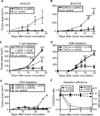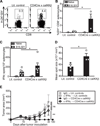Cutting Edge: Engineering Active IKKβ in T Cells Drives Tumor Rejection
- PMID: 26903482
- PMCID: PMC4799771
- DOI: 10.4049/jimmunol.1501144
Cutting Edge: Engineering Active IKKβ in T Cells Drives Tumor Rejection
Abstract
Acquired dysfunction of tumor-reactive T cells is one mechanism by which tumors can evade the immune system. Identifying and correcting pathways that contribute to such dysfunction should enable novel anticancer therapy design. During cancer growth, T cells show reduced NF-κB activity, which is required for tumor rejection. Impaired T cell-intrinsic NF-κB may create a vicious cycle conducive to tumor progression and further T cell dysfunction. We hypothesized that forcing T cell-intrinsic NF-κB activation might break this cycle and induce tumor elimination. NF-κB was activated in T cells by inducing the expression of a constitutively active form of the upstream activator IκB kinase β (IKKβ). T cell-restricted constitutively active IKKβ augmented the frequency of functional tumor-specific CD8(+) T cells and improved tumor control. Transfer of constitutively active IKKβ-transduced T cells also boosted endogenous T cell responses that controlled pre-established tumors. Our results demonstrate that driving T cell-intrinsic NF-κB can result in tumor control, thus identifying a pathway with potential clinical applicability.
Copyright © 2016 by The American Association of Immunologists, Inc.
Figures




References
-
- Mlecnik B, Tosolini M, Kirilovsky A, Berger A, Bindea G, Meatchi T, Bruneval P, Trajanoski Z, Fridman WH, Pages F, Galon J. Histopathologic-based prognostic factors of colorectal cancers are associated with the state of the local immune reaction. J Clin Oncol. 2011;29:610–618. - PubMed
-
- Ulloa-Montoya F, Louahed J, Dizier B, Gruselle O, Spiessens B, Lehmann FF, Suciu S, Kruit WH, Eggermont AM, Vansteenkiste J, Brichard VG. Predictive gene signature in MAGE-A3 antigen-specific cancer immunotherapy. J Clin Oncol. 2013;31:2388–2395. - PubMed
-
- Zhang L, Conejo-Garcia JR, Katsaros D, Gimotty PA, Massobrio M, Regnani G, Makrigiannakis A, Gray H, Schlienger K, Liebman MN, Rubin SC, Coukos G. Intratumoral T cells, recurrence, and survival in epithelial ovarian cancer. N Engl J Med. 2003;348:203–213. - PubMed
Publication types
MeSH terms
Substances
Grants and funding
LinkOut - more resources
Full Text Sources
Other Literature Sources
Research Materials

